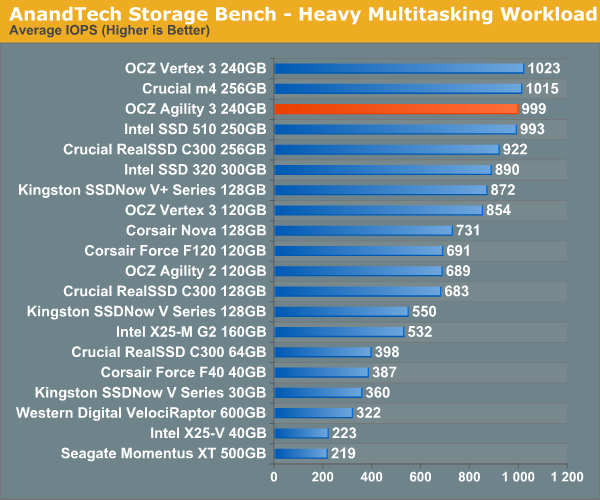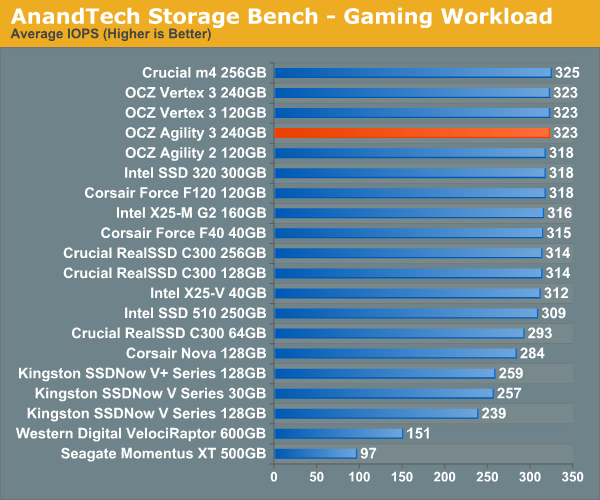OCZ Agility 3 (240GB) Review
by Anand Lal Shimpi on May 24, 2011 2:53 AM ESTAnandTech Storage Bench 2010
To keep things consistent we've also included our older Storage Bench. Note that the old storage test system doesn't have a SATA 6Gbps controller, so we only have one result for the 6Gbps drives.
The first in our benchmark suite is a light/typical usage case. The Windows 7 system is loaded with Firefox, Office 2007 and Adobe Reader among other applications. With Firefox we browse web pages like Facebook, AnandTech, Digg and other sites. Outlook is also running and we use it to check emails, create and send a message with a PDF attachment. Adobe Reader is used to view some PDFs. Excel 2007 is used to create a spreadsheet, graphs and save the document. The same goes for Word 2007. We open and step through a presentation in PowerPoint 2007 received as an email attachment before saving it to the desktop. Finally we watch a bit of a Firefly episode in Windows Media Player 11.
There’s some level of multitasking going on here but it’s not unreasonable by any means. Generally the application tasks proceed linearly, with the exception of things like web browsing which may happen in between one of the other tasks.
The recording is played back on all of our drives here today. Remember that we’re isolating disk performance, all we’re doing is playing back every single disk access that happened in that ~5 minute period of usage. The light workload is composed of 37,501 reads and 20,268 writes. Over 30% of the IOs are 4KB, 11% are 16KB, 22% are 32KB and approximately 13% are 64KB in size. Less than 30% of the operations are absolutely sequential in nature. Average queue depth is 6.09 IOs.
The performance results are reported in average I/O Operations per Second (IOPS):

If there’s a light usage case there’s bound to be a heavy one. In this test we have Microsoft Security Essentials running in the background with real time virus scanning enabled. We also perform a quick scan in the middle of the test. Firefox, Outlook, Excel, Word and Powerpoint are all used the same as they were in the light test. We add Photoshop CS4 to the mix, opening a bunch of 12MP images, editing them, then saving them as highly compressed JPGs for web publishing. Windows 7’s picture viewer is used to view a bunch of pictures on the hard drive. We use 7-zip to create and extract .7z archives. Downloading is also prominently featured in our heavy test; we download large files from the Internet during portions of the benchmark, as well as use uTorrent to grab a couple of torrents. Some of the applications in use are installed during the benchmark, Windows updates are also installed. Towards the end of the test we launch World of Warcraft, play for a few minutes, then delete the folder. This test also takes into account all of the disk accesses that happen while the OS is booting.
The benchmark is 22 minutes long and it consists of 128,895 read operations and 72,411 write operations. Roughly 44% of all IOs were sequential. Approximately 30% of all accesses were 4KB in size, 12% were 16KB in size, 14% were 32KB and 20% were 64KB. Average queue depth was 3.59.

The gaming workload is made up of 75,206 read operations and only 4,592 write operations. Only 20% of the accesses are 4KB in size, nearly 40% are 64KB and 20% are 32KB. A whopping 69% of the IOs are sequential, meaning this is predominantly a sequential read benchmark. The average queue depth is 7.76 IOs.











59 Comments
View All Comments
Shadowmaster625 - Tuesday, May 24, 2011 - link
A pair of 60GB Agility 2 costs a lot less and should mop the floor with these. We need sata 3 like we needed sata 2 in 2005.Arbie - Tuesday, May 24, 2011 - link
Other sites can provide useful comparative info on SSDs, but what really sets Anandtech apart is depth of knowledge and especially the custom test suites you have developed. They tell the story that I as a home desktop user need to know, and nobody else has anything like them.eric appla - Tuesday, May 24, 2011 - link
I wonder if OCZ did something to improve reliability. I have Vertex 2 and it is pain in the back part of my body. I have already third as I had to RMA two of them already and big reseller shops are reporting return ratios as high as 15% for OCZ vertex II series.I wish I never bought it really. Especially in combination with DELL laptop it looks like total fail.
bji - Tuesday, May 24, 2011 - link
Yeah I stay away from OCZ products because I have read far too many anecdotal stories like yours, especially in the reviews of OCZ products on newegg, to feel comfortable buying anything from OCZ. All manufacturers have a percentage of failed parts and that's to be expected; but OCZ always seems to have alot more reports of problems than other vendors. Until that changes for a while, I will not buy anything from OCZ.LuvKush - Tuesday, May 24, 2011 - link
I agree, we really want to see the corsair force 3 or GT's in action 120gb version and 240gb Thanks Anand. Been waiting for those reviews. Also is the 128gb M4 suffer the same fate as the ocz vertex 3 120gb version? as the nands are cut in half and lost performance too? I have the crucial m4 128gb and would love to know if the performance loss is as bad as the 120gb vertex 3 is to the 240gb vertex 3. Thanks again!StuffOfInterest - Tuesday, May 24, 2011 - link
I'd like to see the 60GB Agility benchmarked in a Z68 Smart Response Technology (SRT) configuration. The early tests of SRT showed quite a few tradeoffs between R/W performanc and capacity. Having a SATA-III drive right at the size max for SRT could provide for an interesting comparison against Intels 311 which was designed specifically for SRT.iwod - Tuesday, May 24, 2011 - link
Sequential read performance is lower than the Vertex 3. The 240GB Agility 3 performs more like a 120GB Vertex 2 than its 240GB sibling.Shouldn't it be 120GB Vertex 3?
iwod - Tuesday, May 24, 2011 - link
It would be much more interesting to see how 60GB perform, especially against the Crucial M4 64GB SSD.Oxford Guy - Tuesday, May 24, 2011 - link
I don't understand why this isn't included in the charts, particularly the current "E" model with 25nm 64-bit NAND.Oxford Guy - Tuesday, May 24, 2011 - link
In fact, there isn't a single Vertex 2 drive in these charts. It's bizarre.People would like to see how the 240 GB Vertex 2 fares against the Vertex 3.